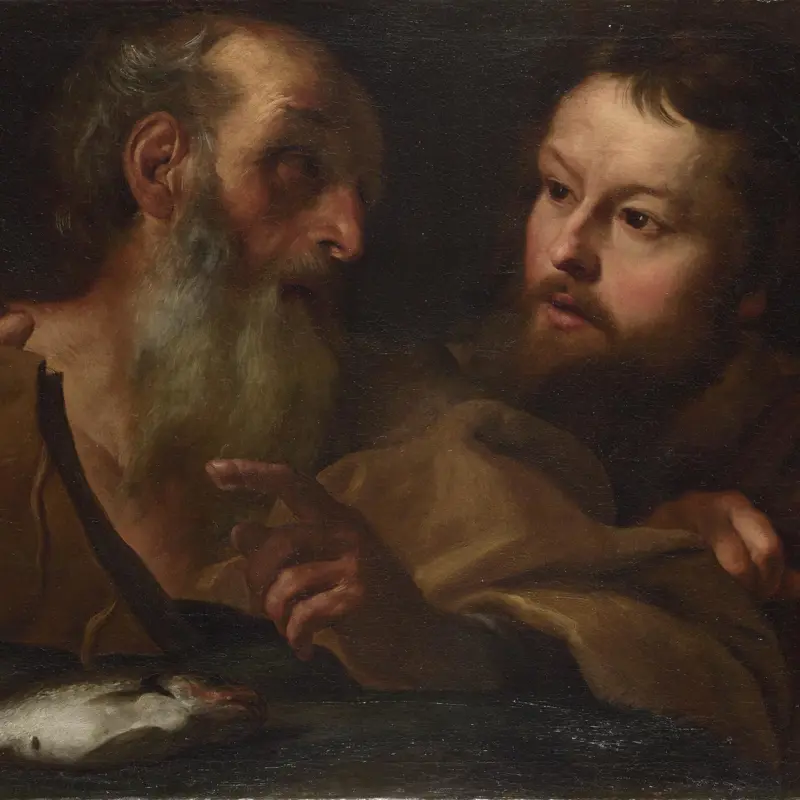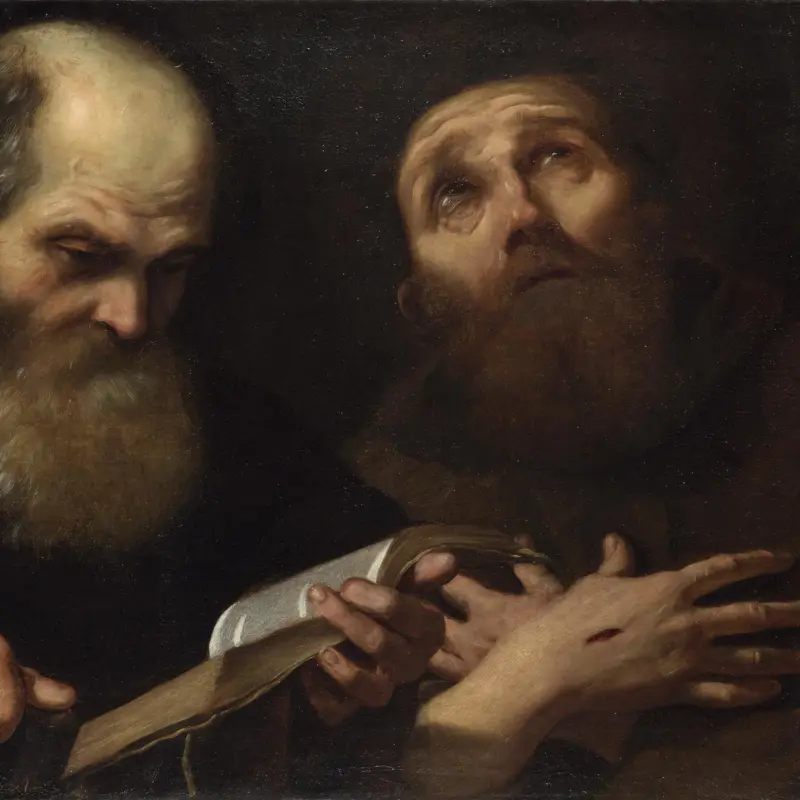Gian Lorenzo Bernini, 'Saints Andrew and Thomas', before 1627
About the work
Overview
Gian Lorenzo Bernini was one of the most successful sculptors and architects of seventeenth-century Rome. This image of Saints Andrew and Thomas is an early work and one of the few paintings he made. Saint Andrew, a fisherman, is identified by the fish and the book (probably a reference to the Acts of Andrew, an apocryphal text written by him). Saint Thomas, a carpenter, is identified by the set square clasped in his right hand.
The two saints, both apostles, were friends and contemporaries, but Bernini was not trying to depict a particular discussion that they were known to have had. Instead he has created a contrast between age and youth, teacher and student. Andrew, balding and grey-haired, points to a passage in his book and turns to explain it to the youthful, animated Thomas, who looks on intensely as understanding begins to dawn on his face. A painting by Andrea Sacchi, Bernini’s contemporary, also depicts two saints and has a similar format and dimensions; it is also in the National Gallery’s collection.
Key facts
Details
- Full title
- Saints Andrew and Thomas
- Artist
- Gian Lorenzo Bernini
- Artist dates
- 1598 - 1680
- Part of the series
- Four Saints for Palazzo Barberini
- Date made
- Before 1627
- Medium and support
- Oil on canvas
- Dimensions
- 61.5 × 78.1 cm
- Acquisition credit
- Bought, 1967
- Inventory number
- NG6381
- Location
- Not on display
- Collection
- Main Collection
Provenance
Additional information
Text extracted from the ‘Provenance’ section of the catalogue entry in Michael Levey, ‘National Gallery Catalogues: The Seventeenth and Eighteenth Century Italian Schools’, London 1986; for further information, see the full catalogue entry.
Exhibition history
-
2017Bernini ScultoreMuseo e Galleria Borghese31 October 2017 - 4 February 2018
Bibliography
-
1969The National Gallery, The National Gallery: January 1967 - December 1968, London 1969
-
1986Levey, Michael, National Gallery Catalogues: The Seventeenth and Eighteenth Century Italian Schools, London 1986
-
2001
C. Baker and T. Henry, The National Gallery: Complete Illustrated Catalogue, London 2001
About this record
If you know more about this work or have spotted an error, please contact us. Please note that exhibition histories are listed from 2009 onwards. Bibliographies may not be complete; more comprehensive information is available in the National Gallery Library.
Images
About the series: Four Saints for Palazzo Barberini

Overview
These paintings were made by two rising stars of the art world in Rome in the 1620s – one by Gian Lorenzo Bernini, the other by Andrea Sacchi. Both depict two saints at half-length, tightly framed and dramatically lit. They are almost exactly the same size, seem to have been made at around the same date and were in the collection of the powerful Barberini family.
It has been suggested that they were made as companion pieces, but documents suggest that the Sacchi painting wasn’t acquired by the Barberini until 1661 at the earliest, more than 30 years after they bought Bernini’s picture. Close examination has also shown that the Bernini painting was trimmed along both vertical sides after it was finished while the Sacchi was extended slightly, presumably so that the sizes of the two would match. On balance, it seems unlikely that they were originally made as a pair. Instead, the similarities seem to have tempted the Barberini family to adapt the pictures and hang them together at a later date.


